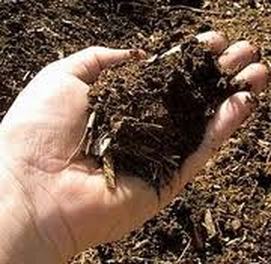 Finished compost and raw organic matter are two excellent amendments to add to your fall garden. If you already have some homemade compost, you’re in great shape. If you don’t, why not get started now? In a neighborhood with many mature trees and shrubs, like Blackridge, homeowners have lots of raw material, like fallen leaves, to begin their own compost pile. Plants killed by frost, vegetable scraps and grass clippings can all be easily composted, as well. Your pile should contain a mix of both carbon-rich (woody materials) and nitrogen-rich (green, leafy wastes) matter. Penn State experts advise that the microorganisms that aid in composting need some moisture, so while the temperature is still above freezing you may need to water the pile from time to time. One way to gauge moisture is the squeeze test: Tightly squeeze a handful of the material. If a few droplets of water come out, it's just about right. If it looks and feels dry as a bone, hose down the compost pile. Take care to aerate your pile regularly to maintain temperatures between 90 degrees F and 140 degrees F in the middle of the compost during the fall and early winter seasons. Once the colder winter weather arrives, the pile will continue to decompose at a slower rate without being turned. Resume turning the compost in the spring. When the pile cools and the organic matter is dark, crumbly, and sweet-smelling—kind of like chocolate cake—the compost is ready to top dress your beds or to mix into your soil. A second suggestion for using your fallen leaves is to incorporate them, together with nitrogen-rich material, into your fall garden beds as raw organic matter (OM). First shred your leaves well with a leaf shredder or simply by running your lawn mower over them several times. Understand that the beneficial soil organisms that will decompose this raw OM require nitrogen to complete the process. If you do not add additional nitrogen-rich material, such as manure or granular organic fertilizer, the microbes will start using up the nitrogen in your soil. You’ll experience the same nitrogen-depleting action if you add raw sawdust or fresh shredded bark mulch to your garden beds.
3 Comments
joe De Stefano
11/17/2011 04:43:39 am
Judy,
Reply
10/4/2012 07:45:28 pm
I like the precious suggestions you shared with us in your expertly written blog post. I want to thank you for this. Nice work.
Reply
8/30/2020 10:26:00 pm
Your thing with respect to making will be for all intents and purposes nothing hard to come by of amazing. This instructive article is unimaginably valuable and contains offered myself a superior answer for have the option to my own issues.
Reply
Leave a Reply. |
Author,
|
Copyright © 2020. All web site design, text, graphics, the selection and arrangement thereof, and all software are Copyright protected under the copyright laws. Any use of materials on this website, including reproduction, modification, distribution or republication, without the prior written consent of Blackridge Garden Club, is strictly prohibited.
 RSS Feed
RSS Feed